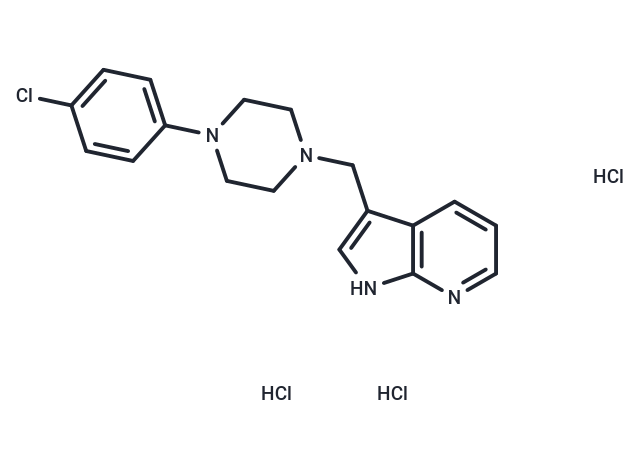Shopping Cart
- Remove All
 Your shopping cart is currently empty
Your shopping cart is currently empty

L-745870 trihydrochloride is a highly potent and selective D4 dopamine receptor antagonist.

| Pack Size | Price | Availability | Quantity |
|---|---|---|---|
| 1 mg | $41 | In Stock | |
| 5 mg | $89 | In Stock | |
| 10 mg | $127 | In Stock | |
| 25 mg | $292 | In Stock | |
| 50 mg | $418 | In Stock | |
| 100 mg | $592 | In Stock | |
| 200 mg | $783 | In Stock |
| Description | L-745870 trihydrochloride is a highly potent and selective D4 dopamine receptor antagonist. |
| Targets&IC50 | D2 receptor:960 nM (Ki), D4 receptor:4.3 nM (Ki), D3 receptor:2300 nM (Ki) |
| In vivo | L-745870 has favorable pharmacokinetic properties in both rats and monkeys, and shows excellent brain permeability and a high brain-to-plasma ratio in rats [1]. L-745870 (10 mg/kg p.o.) at 30 mg/kg caused mild sedation and extrapyramidal motor symptoms, especially bradykinesia, following oral administration to squirrel monkeys. Lower doses of L-745870 had no apparent behavioral effects in monkeys [1]. |
| Alias | L-745,870 trihydrochloride |
| Molecular Weight | 436.21 |
| Formula | C18H22Cl4N4 |
| Cas No. | 866021-03-6 |
| Smiles | ClC1=CC=C(C=C1)N2CCN(CC2)CC3=CNC4=C3C=CC=N4.Cl.Cl.Cl |
| Relative Density. | no data available |
| Storage | Powder: -20°C for 3 years | In solvent: -80°C for 1 year | Shipping with blue ice. | |||||||||||||||||||||||||||||||||||
| Solubility Information | DMSO: 50 mg/mL (114.62 mM), Sonication is recommended. H2O: < 40 mg/mL, Sonication is recommended. | |||||||||||||||||||||||||||||||||||
Solution Preparation Table | ||||||||||||||||||||||||||||||||||||
DMSO
| ||||||||||||||||||||||||||||||||||||

Copyright © 2015-2025 TargetMol Chemicals Inc. All Rights Reserved.